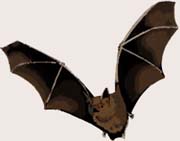Alternatives to Spraying
Besides Prevention, Prevention, Prevention?
Consider A Bat House!
 Consider the community use of a bat house as part of your natural mosquito abatement program. Many zoos, parks, and city managers have installed bat houses in order to provide roosting habitat for their local bat species, as a single bat is capable of eating 500 - 1000 mosquitoes per hour. Though they may not always eat that many mosquitoes, they are known to be an important part of keeping a natural check on exploding mosquito populations. Bats are one of our most beneficial creatures alive. Yet, due to human development and the use of pesticides, the numbers of bats are in serious decline (with some species threatened by extinction).
Consider the community use of a bat house as part of your natural mosquito abatement program. Many zoos, parks, and city managers have installed bat houses in order to provide roosting habitat for their local bat species, as a single bat is capable of eating 500 - 1000 mosquitoes per hour. Though they may not always eat that many mosquitoes, they are known to be an important part of keeping a natural check on exploding mosquito populations. Bats are one of our most beneficial creatures alive. Yet, due to human development and the use of pesticides, the numbers of bats are in serious decline (with some species threatened by extinction).
"With the advent of mosquito-borne West Nile virus, perhaps bats will gain new respect. Spraying for mosquitoes is at best only a temporary measure because insects quickly develop immunity to chemical controls. A more permanent solution is bats, which are mosquito-eating machines. One brown bat can consume 1,200 mosquitoes in an hour." (Denver Post, 9/14/03)
* * *
Bats Offer Alternative Pest Control
(Daily News Archive ,Beyond Pesticides, November 1, 2001) Homeowners in Florida are beginning to look toward bats to combat nuisance insects in their neighborhood, according to Environment News Service. Florida residents have been increasingly concerned about insect pests since July when West Nile Virus was found in the state. Since then, the use of backyard bat houses has been on the rise. Bats feed on up to 1,000 flying insects per night, including mosquitoes, moths and flies.
A bat house provides shelter for bats during the day. They tend to stay within the area of the house during night. Since bats are peaceful creatures, many species will share the same space in a bat house. On average, most residential bat houses will hold 100 to 300 bats. The University of Florida's Institute of Food and Agriculture Sciences created a house that is host to 100,000 bats, now a landmark in the area.
This type of pest control has been used in Europe since the 1960's and first started being used in the United States in the mid 1980's. As bat houses become more popular, certain myths will likely be dispelled. For example, contrary to popular belief, the rate of rabies in bats is very low. Also, it is possible to block bats' access to areas where they may be unwanted.
How much mosquito control can we really expect from our flying friends?
Dr. Merlin Tuttle of Bat Conservation International
A few of the cities/groups that are working to attract bats for assistance with mosquito abatement:
Boykins, Virginia
Davis County, Utah
Montgomery County, Maryland
Deltona, Florida
Toronto, Canada
Parker, Denver
To learn more about building and maintaining a residential or community bat house, visit:
North American Bat House Research Project
Organization for Bat Conservation
Maryland Department of Environmental Protection
For more information on bats, bat species, locations, additional links, etc., visit:
Bat Conservation International
Organization for Bat Conservation
Bat Rescue
Amazing Bat Facts (Bats of San Diego County)
Buzbee's Bat House (Scroll to links at bottom of homepage)
12 Bat Facts
by California Bat Conservation Fund
1. Bats are one of the most misunderstood & persecuted animal in the world.
2. Bats are VITALLY important to our ecosystem (no bats, no Rain Forests, & no Tequila!)
3. Their numbers have declined 80% in the last 20 years (mostly due to humans & pesticides).
4. They are NOT “Flying Rodents”.
5. They are in an order all by themselves, the order “Chiroptera” (meaning Hand Wing).
6. They are the Only Mammal with natural flight (wings).
7. They don’t attack people, or get tangled in their hair, if they do fly close to you, they are just chasing insects (who are probably chasing you). If they fly into your house they are chasing insects and most likely it will be a juvenile who is just learning the ropes & to fly.
8. They eat millions of insects every night, we would literally be over run by insects if not for bats.
9. Vampire bats live only in South America (& they don’t even like human blood) They are also a very misunderstood & persecuted bat. They are about the only bat known to feed another bats babies or a sick or injured bat that can’t go out & hunt for their own food.
10. Bats are probably the cleanest of all mammals, they are constantly grooming themselves if not sleeping or hunting for food.
11. Most bats are NOT rabid, as was a popular belief a few a years ago. Less than ½ of 1% get rabies. They actually have less incidence of rabies than other rabies vector animals & if they contact rabies, they don’t spread it to the rest of the colony because they don’t become aggressive, they just are sick & finally die.
12. Bats desperately need our help, understanding & protection, not our misconceptions & myths about them. Please get educated about bats before you believe any of the many lies & myths about one of the most beautiful, gentle & beneficial animals on earth.








